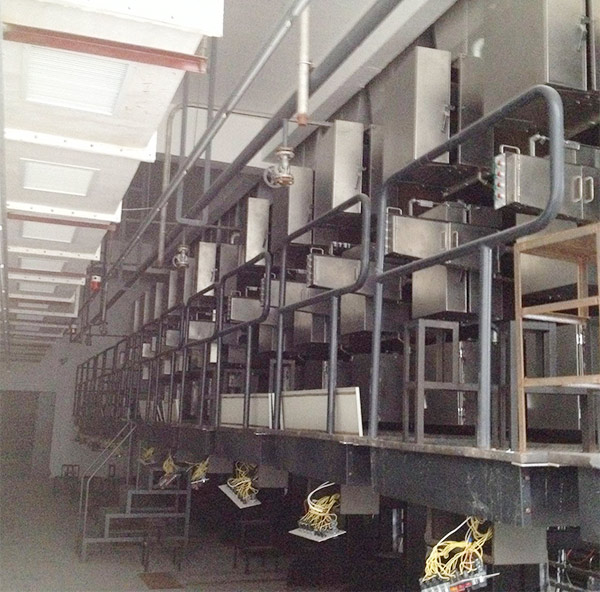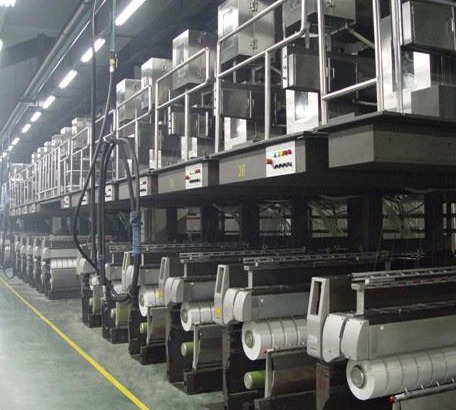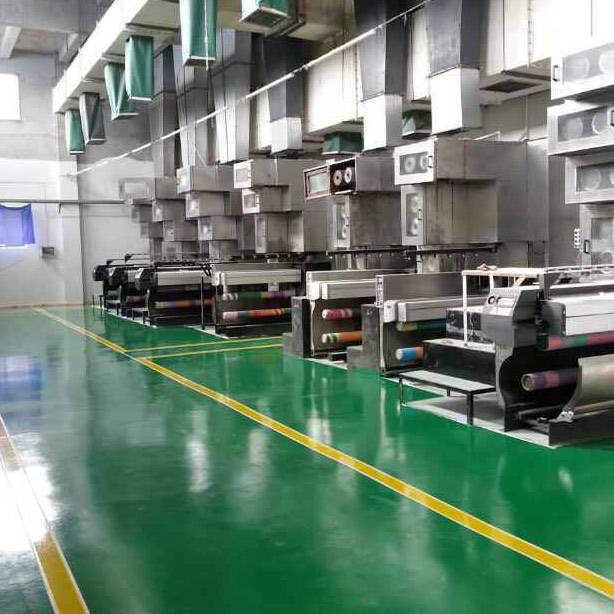- Polypropylene spinning machine
- Polypropylene FDY equipment
- Polyester POY spinning machine
- Polyamide FDY common and high strength equipment
- Polyester FDY equipment
- Polyester high strength equipment
- polyester、Polyamide、 Polypropylene BCF equipment
- Small spinning machine
- All kinds of spinning special parts
- Focus on six core modules to unlock new driving forces for the upgrading of the recycled fiber industry chain
- The China (Shishi) International Textile and Apparel Expo and the National Fashion Textile and Apparel Supply Chain Exhibition kicked off
- Argentina has lifted anti-dumping duties. The Textile Association has taken measures to break the deadlock and help foreign trade enterprises navigate the international market!
- Cotton textile industry fifteen five development guidance seminar was held in Anqing
- Explore the spinning machine: four functional areas, open the secret door of fiber production

- Contact:Mr. Huang Guofu
- Cel:0086-13901505556
- Fax:0086-519-83341119
- Email:czfb5556@126.com
- Add:No. 288-8 ChangLi Rd, Huangli Town, Changzhou, JS PRV.
Since the beginning of this year, the Russia-Ukraine conflict has continued, the international financial environment has tightened, the terminal demand of major developed economies in the United States and Europe has weakened, stubborn inflation and other risk factors have led to a sharp slowdown in global economic growth. With the rise of global real interest rates, the recovery prospects of emerging economies have frequently suffered setbacks, financial risks have been accumulating, and trade improvement has been even more weak.
Order protection or profit protection? Textile enterprises or will usher in a big test!
Under the premise of the decline of terminal textile and garment exports in 2023, the foreign trade volume of cotton and polyester filament has ushered in explosive growth, and some institutions and enterprises do not understand and are unexpected.
Industry analysis is mainly driven by the following factors:
First, by the United States, the European Union and other restrictions on the upgrading of Xinjiang cotton import ban, some domestic textile and clothing enterprises will be traceable orders to Vietnam, Thailand, Indonesia, Pakistan and other countries cotton textile enterprises processing (or its branch), and considering the Southeast Asia/South Asia countries printing and dyeing capacity/level is poor and clothing design, processing is insufficient (worried about not meeting customer requirements), Therefore, cotton still needs to "return" to the country, and then exported in the form of clothing.
Second, although a large number of orders from Europe, the United States, Japan and South Korea and other countries have "flown to the southeast" since 2020, the printing and dyeing equipment and technical level of Southeast Asia/South Asia countries are low, especially the export of high-end high-value-added orders to Europe and the United States and other countries (previously mainly relying on direct imports of cotton, fabrics, clothing made in China). Can only entrust Chinese dyeing factory for its cotton cloth processing (Bangladesh, Pakistan and other countries to the garment processing industry as the leading).
In recent years, including Thailand, Malaysia, Indonesia, Cambodia and other Asian countries and some African textile industry has developed rapidly, but they are non-cotton main producing countries, so most of the "heavy textile", printing and dyeing enterprises are few, the serious shortage of supporting facilities, many companies are difficult to complete clothing orders alone, cotton export prices than domestic cotton also have some advantages.
Fourth, since 2023, the prosperity of new export orders is low, mainly short orders, small orders, bulk orders, medium and long line large orders are obviously insufficient, taking into account the general delivery time is tight, quality index requirements are not high and profit margins are slightly poor characteristics, fabric, clothing, foreign trade companies tend to directly purchase cotton dyeing, not only to shorten the performance cycle, but also to avoid European and American customer traceability problems.
Manufacturers rush ahead to stimulate polyester filament exports
As for the export of polyester filament, in the first half of the year, the textile and garment industry chain alternated between hot and cold, textile and garment exports declined, and polyester filament and staple fiber exports became the only growth seedlings, mainly due to the influence of India BIS certification, manufacturers catch up in advance, and the influence of this factor can only last until June; In addition, Dachang is also actively expanding overseas markets this year, and its export performance is obviously better.
According to customs statistics, the export of polyester filament and staple fiber to India increased by 194,000 tons, an increase of 219%. India's export increase alone accounted for about 38% of the overall increase in polyester exports, and the increase in polyester filament alone accounted for 46%. India for polyester filament for the implementation of BIS mandatory certification news in the industry has been rumored for a long time, the industry believes that in July this year began to implement polyester POY, FDY, industrial silk, due to the uncertainty of the application for certification, many manufacturers choose to ship in advance to deal with.
The advance shipment greatly boosted the polyester trade between China and India, last year from January to May, the top three countries for the export of polyester are Vietnam, Pakistan, Turkey, India in 7th place, the share of only 5%, and this year in January, 2, May, the first export is India, the total share of 13% in January to May, ranking first.
In the future, the trend of domestic chemical fiber products is export, the downstream production growth rate of foreign chemical fiber is very high, and the demand gap of chemical fiber products is gradually expanding. At the same time, domestic production capacity continues to expand, and more markets are needed.
Macroeconomic environment of textile industry
Since 2023, the sluggish recovery of the world economy has continued. The negative effects of interest rate hikes in developed economies on economic growth continue to emerge, uncertainties such as banking turmoil and persistent inflation increase the risk of economic recession, balance sheets of households, enterprises and other sectors are damaged, and the demand-side pressure has not eased since the second quarter. The Organisation for Economic Co-operation and Development's consumer confidence index came in at 98.2, back to its highest level in 15 months but still in contraction territory for the 21st month in a row.
From the supply side, the global manufacturing economy has been in the contraction range for 9 consecutive months, J.P. Morgan manufacturing purchasing managers index (PMI) has been maintained at 49.6 from March to May, of which the new export orders index is only 47.3, falling to a new low in 9 months; Among developed countries on record, only Japan's May PMI was in expansionary territory. The WTO goods Trade barometer index released in May was 95.6, up slightly by 3.4 percentage points from the first quarter, and still below the trend level of 100. The global inflation level has maintained a high downward trend, and the IMF primary commodity price index in May was 158.3, a significant drop of 67.8 percentage points from the same period of last year, and basically returned to the level of the same period in 2021.
China's macroeconomic overall continued to recover, production and domestic and foreign sales growth slightly accelerated compared with the first quarter, profit decline slightly narrowed compared with the first quarter, but compared with the same period last year, only the growth rate of domestic sales indicators increased, the growth rate of other major operating indicators slowed down.
Textile industry overall pressure operation. Thanks to the recovery and rebound of domestic consumption growth, domestic sales in the industry achieved better growth, the scale of the remaining operating indicators were reduced year-on-year, the quality and efficiency of operation declined, and the market performance was lower than expected during the peak season, which failed to change the industry's low operation situation.
Declaration: This article is organized from the network, copyright belongs to the original author;
If there is infringement, please inform in time and delete after verification.
Changzhou Fubon Chemical Fiber Machinery Factory Technical is a professional manufacturing supplier that develops and produces various chemical fiber machinery as its main body. It integrates scientific research, development, production and sales. In order to meet market demand, our factory has established a comprehensive chemical fiber spinning silk silk Experimental base provides customers with good equipment and technical services. We mainly provide customers with various chemical fiber sets of equipment such as polyester, Parion, nylon, aminoly, and undertake various related equipment transformation projects and custom services.
- The China (Shishi) International Textile and Apparel Expo and the National Fashion Textile
- Focus on six core modules to unlock new driving forces for the upgrading of the recycled f
- Argentina has lifted anti-dumping duties. The Textile Association has taken measures to br
- Cotton textile industry fifteen five development guidance seminar was held in Anqing
- Explore the spinning machine: four functional areas, open the secret door of fiber product
- Manager must read | say goodbye to control management, release the potential of employees,
- Empower the traditional garment industry with digital technology
- Fubon Chemical fiber Polyester industrial silk spinning and drawing machine equipment: the
- Textile information | Industry empowerment, when calligraphy meets fabric, Keqiao textile'
- High performance carbon fiber and composite material technology and equipment seminar was




